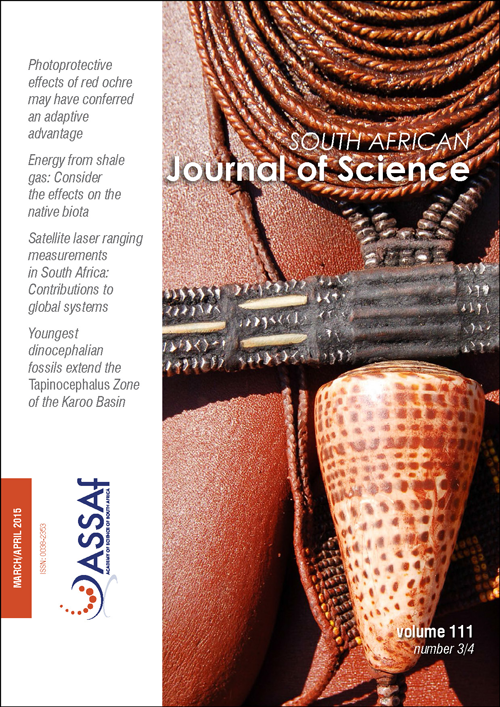Use of wood anatomy to identify poisonous plants: Charcoal of Spirostachys africana
DOI:
https://doi.org/10.17159/sajs.2015/20140143Keywords:
Middle Stone Age, Sibudu, hearth, tambotie, EuphorbiaceaeAbstract
Spirostachys africana Sond. (tamboti/tambotie) is a woodland tree that is often found near water. It has a poisonous and purgative latex. The archaeological site of Sibudu, a rock shelter in KwaZulu-Natal, has evidence, from well-preserved charcoal and seeds, of past environments and wood use from approximately 77–38 thousand years ago (ka). As their uses and environmental indicators are different, it is critical to confidently distinguish among the three anatomically similar woods of the Euphorbiaceae: Spirostachys africana, Sclerocroton integerrimus and Shirakiopsis elliptica. A detailed anatomical study of reference and archaeological charcoal shows that xylem vessel width increases proportionally as vessel frequency decreases, from Spirostachys africana, Sclerocroton integerrimus to Shirakiopsis elliptica. Crystals of calcium oxalate are present in ray cells of Spirostachys africana, whereas silica bodies are present in ray cells of Sclerocroton integerrimus and Shirakiopsis elliptica. Using these features, the presence of Spirostachys africana was confirmed amongst hearth charcoal of the Spotty Camel layer, with an age of approximately 58 ka and of the Mottled Deposit occupational layer, with an age of approximately 49 ka. The presence of this charcoal, collected from ancient fireplaces or sieved from surrounding sediments, implies that people at Sibudu understood and used this poisonous tree to their advantage. We are encouraged in this view by the presence of many Cryptocarya woodii leaves found on the surface of 77-ka sedge bedding at Sibudu (Wadley L et al., Science. 2011;334:1388–1391). Cryptocarya woodii has insecticidal and larvacidal properties and members of the Laurel family are well known for their medicinal properties.
Published
Issue
Section
License

All articles are published under a Creative Commons Attribution 4.0 International Licence
Copyright is retained by the authors. Readers are welcome to reproduce, share and adapt the content without permission provided the source is attributed.
Disclaimer: The publisher and editors accept no responsibility for statements made by the authors
How to Cite
- Abstract 622
- PDF 654
- EPUB 212
- XML 234













.png)